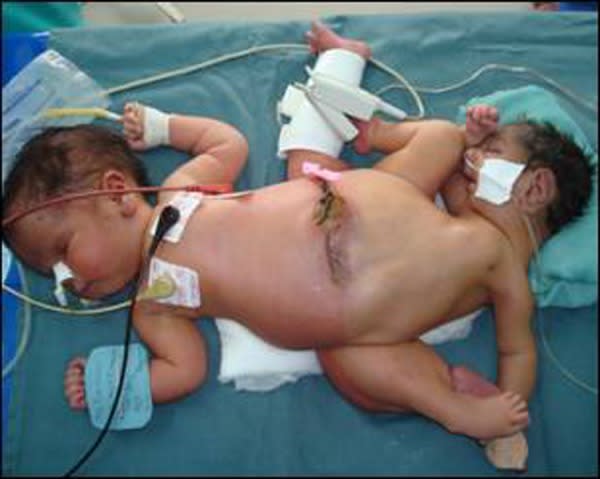One in 2 million ‘spider twins’ have 3 legs, 4 arms and 1 penis

These conjoined “spider” twins in Indonesia are connected at the pelvis in such a way that they possess three legs, four arms and one penis, a condition so rare that it affects just one in 2 million people.
While the anomalously attached siblings came into the world in 2018, the case was only just detailed recently in the American Journal of Case Reports.
The boys are ischiopagus-tripus conjoined twins, defined as those who are connected by the lower half of their body instead of the upper torso — which is the case with most conjoined twins. This subset of the birth defect is exceedingly rare.


Along with their shared penis and seven limbs — all of which are functional except for one leg — these brothers also possess a bladder, rectum and intestinal tract, as is typical of most conjoined twins, the Daily Mail reported.
Meanwhile, doctors believe that one of the boys had an underdeveloped kidney while the other only possessed one.
Despite miraculously surviving both gestation and childbirth — one twin dies or is stillborn in over 60% of cases — the brothers had to lie flat for their first three years as their unique configuration prevented them from sitting up.
Surgeons have since amputated their third leg and stabilized their hip and pelvis so the brothers could sit upright, providing them a semblance of independence.
Meanwhile, a three-month follow-up appointment revealed that the twins didn’t suffer any complications from the operation.


It’s yet unclear whether doctors will try and separate the twins — an undertaking that could prove especially complicated considering the unusual nature of their union.
“The rarity of ischiopagus tripus conjoined twins complicates the surgical separation, owing to the lack of cases and high complexity,” the study authors explained.
Nonetheless, surgeons believe that the case study ultimately demonstrates that “there is still room for surgical correction to be performed” even in situations where separation is impossible.
In 2022, doctors managed to separate two conjoined twins in China who had two functioning arms, two working legs, and one non-responsive fused leg.
The twins also shared a penis and testes but had no anus.
According to the Mayo Clinic, conjoined twins are the result of a congenital defect that occurs when the embryo “only partially separates to form two individuals.”
While the babies develop from this embryo, they remain physically joined, most “often at the chest, abdomen or pelvis.”
Of the conjoined twins, only 6 to 11% of conjoined twins are ischiopagus.

 Yahoo News
Yahoo News 
